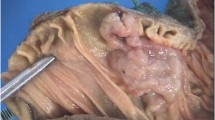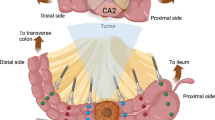Abstract
We hypothesized that epithelial cells of the remnant small intestine display “colonic” phenotype after total proctocolectomy. The aims of the present study were to identify preferentially expressed molecules in the colon or in the small intestine and to evaluate mRNA levels of those in the ileal pouch. Differential gene expression was investigated between the small intestine and the colon by using cDNA microarray and was confirmed by Northern blotting. Expression of three colonic mRNAs (3-hydroxy-3-methylglutaryl-coenzyme A synthase 2, deleted malignant brain tumors 1, carcinoembryonic antigen-related cell adhesion molecule 1) and one “small intestinal” (microsomal triglyceride transfer protein) mRNA were compared between the control and the ileal pouch mucosae by quantitative reverse transcriptase-polymerase chain reaction. Seventy-four clones were differentially expressed with more than a threefold difference. Differential expression was confirmed in all mRNAs examined, including 3-hydroxy-3-methylglutaryl-coenzyme A synthase 2 and microsomal triglyceride transfer protein. The mucosal expression of carcinoembryonic antigen-related cell adhesion molecule 1 mRNA in the ileal pouch was enhanced in humans. The remnant ileum develops some, but not all, colonic phenotype after total proctocolectomy. Comparative study of epithelial gene expression between the small intestine and the colon enables us to analyze mechanisms of intestinal adaptation after total proctocolectomy.
Similar content being viewed by others
References
Utsunomiya J, Iwama T, Imajo M, et al. Total colectomy, mucosal proctectomy, and ileoanal anastomosis. Dis Colon Rectum 1980;23:459–466.
Koyama K, Sasaki I, Naito H, et al. Induction of epithelial Na + channel in rat ileum after proctocolectomy. Am J Physiol 1999;276:G975-G984.
Sato S, Fukushima K, Naito H, et al. Induction of 11β-hydroxysteroid dehydrogenase type 2 and hyperaldosteronism are essential for enhanced sodium absorption after total colectomy in rats. Surgery 2005;137:75–84.
Fukushima K, Sato S, Naito H, et al. Comparative study of epithelial gene expression in the small intestine among total proctocolectomized, dietary sodium-depleted, and aldosterone-infused rats. J Gastrointest Surg 2005;9:236–244.
Adachi M, Kitamura AK, Miyoshi T, et al. Activation of epithelial sodium channels by prostasin in xenopus oocytes. J Am Soc Nephrol 2001;12:1114–1121.
Funder JW, Pearce PT, Smith R, Smith AI. Mineralocorticoid action: Target tissue specificity is enzyme, not receptor, mediated. Science 1988;242:583–585.
Edwards CR, Stewart PM, Burt D, et al. Localisation of 11 beta-hydroxysteroid dehydrogenase-tissue specific protector of the mineralocorticoid receptor. Lancet 1988;2:986–989.
Loo DDF, Zeuthen T, Chandy G, Wright EM. Cotransport of water by the Na +/glucose cotransporter. Proc Natl Acad Sci U S A 1996;93:13367–13370.
Ogawa H, Fukushima K, Sasaki I, Matsuno S. Identification of genes involved in mucosal defense and inflammation associated with normal enteric bacteria. Am J Physiol 2000;279:G492-G499.
http://www.incyte.com/expression/easy_to_spot. 2001
Fukushima K, Ogawa H, Takahashi K, et al. Non-pathogenic bacteria modulate colonic epithelial gene expression in germ-free mice. Scand J Gastroenterol 2003;38:626–634.
http://www.nebi.nih.gov/BLAST. 2005
Fukushima K, Sasaki I, Sato S, Sasano H, Krozowski Z, Matsuno S. Induction of mineralocorticoid receptor by sodium butyrate in small intestinal (IEC6) and colonic (T84) epithelial cell lines. Dig Dis Sci 1999;44:1571–1578.
Shen B, Achkar JP, Connor JT, et al. Modified pouchitis disease activity index: A simplified approach to the diagnosis of pouchitis. Dis Colon Rectum 2003;46:748–753.
Athman R, Louvard D, Robine S. The epithelial cell cytoskeleton and intracellular trafficking III. How is villin involved in the actin cytoskeleton dynamics in intestinal cells? Am J Physiol Gastrointest Liver Physiol 2002;283:G496-G502.
Huber F-X, Stern J, Hinz U, et al. Effects of restorative proctocolectomy on renal and adrenal function. Dis Colon Rectum 1999;42:1318–1324.
Bates MD, Erwin CR, Sanford LP, et al. Novel genes and functional relationships in the adult mouse gastrointestinal tract identified by microarray analysis. Gastroenterology 2002;122:1467–1482.
Mollenhauer J, Herbertz S, Holmskov U, et al. DMBT1 encodes a protein involved in the immune defense and in epithelial differentiation and is highly unstable in cancer. Cancer Res 2000;60:1704–1710.
Fukushima K, West GA, Fiocchi C. Adequacy of mucosal biopsies for evaluation of intestinal cytokine-specific mRNA: A comparative study of RT-PCR in biopsies and isolated cells from normal and inflamed intestine. Dig Dis Sci 1995;40:1498–1505.
Maunoury R, Robine S, Pringault E, Gaillard JA, Louvard D. Developmental regulation of villin gene expression in the epithelial cell lineages of mouse digestive and urogenital tracts. Development 1992;115:717–728.
Prall F, Nollau P, Neumaier M, et al. CD66a (BGP), an adhesion molecule of the carcinoembryonic antigen family, is expressed in epithelium, endothelium, and myeloid cells in a wide range of normal human tissues. J Histochem Cytochem 1996;44:35–41.
Frangsmyr L, Baranov V, Prall F, Yeung MMW, Wagener C. Cell- and region-specific expression of biliary glycoprotein and its messenger RNA in normal human colonic mucosa. Cancer Res 1995;55:2963–2967.
Muenzner P, Billker O, Meyer TF, Naumann M. Nuclear factor-kB directs carcinoembryonic antigen-related cellular adhesion molecule 1 receptor expression in Neisseria gonorrhoeae-infected epithelial cells. J Biol Chem 2002;277:7438–7446.
Lammers KM, Vergopoulos A, Babel N, et al. Probiotic therapy in the prevention of pouchitis onset: Decreased interleukin-1beta, interleukin-8, and interferon-gamma gene expression. Inflamm Bowel Dis 2005;11:447–454.
Author information
Authors and Affiliations
Corresponding author
Additional information
Supported by Grant-in-Aid for Scientific Research, grant 10557118 to K.F. and grant 14657295 to K.F. from the Ministry of Education, Science and Culture of Japan and by Kanae Foundation to K.F.
Rights and permissions
About this article
Cite this article
Fukushima, K., Haneda, S., Funayama, Y. et al. An approach to analyze mechanisms of intestinal adaptation following total proctocolectomy. J Gastrointest Surg 10, 662–671 (2006). https://doi.org/10.1016/j.gassur.2005.09.025
Published:
Issue Date:
DOI: https://doi.org/10.1016/j.gassur.2005.09.025




